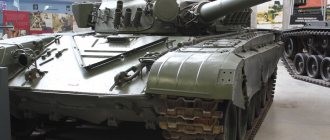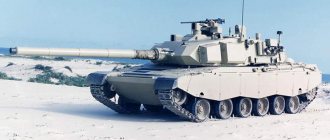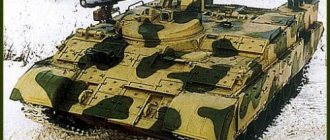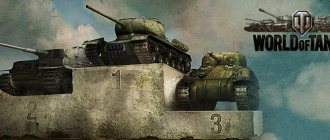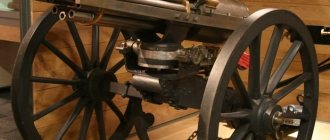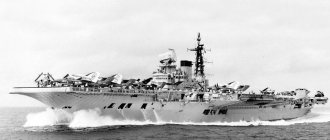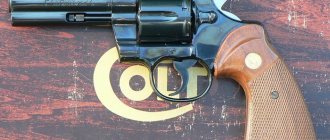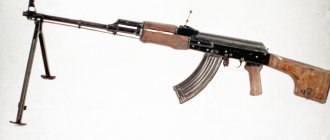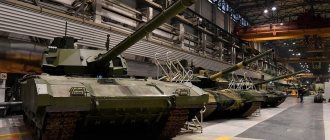The most famous tank created in the USSR. According to popular opinion, it is the leader in the “Best Tanks of World War II” category. Direct descendant of BT light tanks. The prototype of the T-34 were experimental light tanks - the wheeled-tracked A-20 and the tracked A-32. In the summer of 1939, comparative tests of the A-20 and A-34 vehicles were carried out at the Kharkov training ground, during which the similarity of their performance characteristics was revealed. Both tanks showed approximately equal speed on the tracks. After passing the tests, it was decided to build a new tank, with the index A-34, based on the A-32 prototype.
Birth of the T-34.
During February-March 1940, two T-34 prototypes made the transition from Kharkov to Moscow under their own power.
Chief designer M. Koshkin and designer Alexander Aleksadrovich Morozov took direct part in the run. Seriously ill, Koshkin himself sat down at the levers of the T-34 more than once. The disease progressed and on September 26, 1940 M. Koshkin died. He was posthumously awarded the State Prize for his contribution to the creation of the T-34. On March 17, 1940, the T-34, among other types of military equipment, was presented to the leadership of the state and army. The tanks generally made a favorable impression, and it was decided to begin production of new vehicles at KhPZ No. 183. The target of 150 vehicles, initially set, was soon quadrupled. But due to production difficulties, only 115 medium tanks could be produced until 1941. In the forties, the cost of the T-34 was 429,596 rubles according to KhPZ reports and 510,000 rubles according to the People's Commissariat of Medium Engineering.
A-32
Performance characteristics
| A-32 | |
| Length, m | 5,76 |
| Length with gun, m | |
| Width, m | 2,73 |
| Height, m | 2,44 |
| Combat weight, t | 19,0 |
| Armament | |
| A gun | 1 x 76mm L-10 |
| Machine guns | 2 x 7.62 mm DT |
| Mobility | |
| Max speed on highway, km/h | 75 |
| Cruising range on the highway, km | |
| Booking | |
| Body forehead, mm | 20 |
| Sides and stern of the hull, mm | 30 |
| Tower forehead, mm | |
| Sides and stern of the tower, mm | 25 |
| Roof, mm | 10 |
| Bottom, mm | 10 |
Start of production.
In the winter of 1940, three production T-34s went on a Kharkov-Kubinka-Smolensk run to identify design flaws. The officers of the BT Research Institute who carried out the tests found so many shortcomings that the report they submitted was not left to the Deputy People's Commissar of Defense Marshal G.K. Kulik has no choice but to give the order to stop the production and acceptance of the T-34. In return, it was decided to speed up the development of a new medium tank, the A-43, with torsion bar suspension and improved armor.
Head of ABTU Ya. Fedorov, with whom G.K. agreed. Kulik proposed to leave the BT-7M in production and speed up work on the T-50. The management of the Kharkov plant did not agree with such an unforestable assessment and the proposal to put an end to their brainchild and insisted on continuing production, proposing to temporarily reduce the warranty mileage of the car, which was supposed to be a thousand kilometers, by three times. The dispute was stopped by Voroshilov, who, although at that time he lost the high position of People's Commissar, but as a member of the Politburo of the Central Committee and as an old Bolshevik, he did not lose his influence, both on Stalin and on the chairman of the Council of People's Commissars, Molotov. It was his recommendation that allowed the continuation of production of the T-34 until it was replaced in production by the T-43M.
Less than six months later, the Second World War showed the correctness of this decision. T-34, the production of which was launched in Stalingrad and Kharkov, made it possible to quickly organize their production at enterprises in rear areas during the war period. From the moment it was put into production until the start of the war, the new T-34 was manufactured in quantities of about 1,225 units. With the beginning of the mobilization of industry, Gorky (manufacturer No. 112) joined the production of the tank.
Pre-war perspective
As the practice of world tank building shows, in peacetime the cycle for creating a fundamentally new combat vehicle from the first requirements to a completed model is about five years. Often, during development and mass production, a tank changes significantly - this is exactly what happened with the T-34. The initial tactical and technical requirements for the future BT-20, dated mid-October 1937, envisaged a wheeled-tracked tank weighing 13-14 tons with armor 20-25 mm thick, as well as armament in the form of a 45 mm or 76 mm gun (L -10). Three years later, a purely tracked tank with a combat weight of 25.6 tons with a 76 mm L-11 cannon and 45 mm thick armor went into production.
During production, the combat weight gradually increased, and at the same time, the vehicle’s characteristics also improved. Moreover, already in the summer of 1941, the T-34 was supposed to change significantly. Tank T-34M
was the result of changing requirements. The outbreak of the Great Patriotic War prevented the work from being completed even to a prototype, but the T-34M became the starting point for the creation of a whole series of vehicles, and also had a significant influence on the serial T-34.
Big modernization
The T-34 tank began to undergo various changes from the very beginning of mass production. The turret was expanded, a hatch appeared instead of the driver's cabin (booth) from the very beginning of production, and the radio station was moved to the building. Various alterations and improvements were made almost every month. To a person not particularly knowledgeable in these matters, it may seem that the designers made a “raw” tank that was constantly being refined, but this is not so. Almost any tank that had a fundamentally new design went through a similar stage of “settling down,” and the T-34 was just like that.
Compared to foreign analogues, work to improve the T-34 looked quite small. For example, the German medium tank Pz.Kpfw.III, the closest analogue and main opponent of the T-34 in the battles of 1941-1942, was “born” in much greater pain. In the first three years of production, the “three-ruble car” had the engine changed once, the gearbox three times, and the chassis and suspension three times. The Pz.Kfw.III chassis was finally formed only in the second half of 1940. At the same time, the initial ZW project assumed a combat weight of within 12 tons, the first production version had a weight of 15 tons, and the Pz.Kpfw.III Ausf.H already had a weight of 21.5 tons.
Torsion bar suspension diagram for the modernized T-34, drawing dated January 17, 1941.
Pz.Kfw.III is mentioned not just as an example. The acquisition of one Pz.Kpfw.III Ausf.G model from Germany also had an impact on the T-34 program. From the point of view of weapons or armor, the German tank did not impress Soviet designers, but aroused considerable interest from both the Main Armored Directorate of the Red Army (GABTU KA) and tank design bureaus. The vehicle had better observation devices, a three-seat turret with a commander's cupola, a torsion bar suspension, which was more successful than the spark plug suspension of the T-34, and also turned out to be faster. Based on the results of studying the Pz.Kpfw.III, they decided to develop some successful elements, including the commander’s cupola, for Soviet tanks. In addition, under the influence of this vehicle, the requirements for some tanks, for example, the future T-50, have changed somewhat.
With a maximum speed of almost 70 km/h, things were not so clear. In the fall of 1940, the Germans themselves switched to producing the not so fast Pz.Kpfw.III Ausf.H - this was due to problems with the 10-speed gearbox and the rubber weights of the road wheels, which quickly failed at high speeds. In the Soviet Union, of course, they did not know about such changes. On September 25, 1940, to the People's Commissar of Medium Engineering I.A. Likhachev received a letter from GABTU with proposals for modernizing tanks, which indicated 23 points of improvement for the T-34. These included the appearance of a commander's cupola, an increase in the crew to 5 people, the installation of a planetary rotation mechanism, changes in viewing devices, as well as the replacement of a spark plug suspension with a torsion bar suspension with the installation of hydraulic shock absorbers. Not all points of improvement were related specifically to the Pz.Kpfw.III, however, some influence of the German vehicle is still obvious.
The first version of the hull of the T-34 modernization project with linings on the sides.
This proposal began to be actively discussed at the level of the People's Commissariat of Defense (NKO) and the People's Commissariat of Medium Engineering (NKSM). The result of the discussion was the adoption on November 19, 1940 of the resolution of the Defense Committee under the Council of People's Commissars of the USSR No. 428ss "On additions and changes to the tactical and technical requirements for KV, T-34 and T-40 tanks." At the instigation of the NKSM and the People's Commissariat of Heavy Engineering (NKTM), the planned modernization of the T-34 turned out to be much less profound than proposed by the leadership of the GABTU KA. It was planned to install the V-2K engine from the KV-1, expand the turret (without increasing the diameter of the turret ring), installing a commander's cupola, and also consider the possibility of installing a torsion bar suspension. Such modest metamorphoses were explained primarily by the desire to obtain, perhaps, a less advanced, but more reliable tank in the shortest possible time. The fact is that at the same time the requirements for reliability increased. However, the GABTU KA considered such “soft” points of Resolution No. 428ss to be insufficient. They believed that it was necessary to expand not only the turret, but also its shoulder straps (up to 1600 mm), and also make the commander a separate member of the crew.
GABTU KA engineer Lieutenant Colonel I.G. arrived at plant No. 183. Panov familiarized himself in detail with the capabilities of the machine tools. According to a report dated December 13, 1940, plant No. 183 had the necessary machine equipment for the production of shoulder straps with a diameter of 1600 mm. At the same time, installing a V-2K engine, on the contrary, was considered extremely undesirable. The fact is that the existing gearbox was designed for a less powerful engine and for less heavy A-20 and A-32 tanks. In addition, the GABTU considered the transition to torsion bar suspension to be an extremely important event. In addition to the fact that significant longitudinal vibrations were observed on the BT, the spark plug suspension had a number of other disadvantages - for example, the large volume occupied by the suspension inside the fighting compartment and the presence of cutouts for balancers in the sides of the hull. According to calculations, switching to a torsion bar suspension would increase the internal volume of the fighting compartment by 20%, reduce the weight of the vehicle by 300-400 kg, increase the fuel supply from 465 to 750 liters, and also increase the strength of the lower side sheets. In addition, the torsion bar suspension had an advantage in terms of its maintenance. An additional trump card was that the production base of plant No. 183 made it possible to produce torsion bars, and besides, torsion bar suspension was by no means something new. The KV and T-40, adopted on the same day as the T-34, had just such a suspension. The T-50, created at the same time, was also designed with a torsion bar suspension.
The second version of the modernization had upper side sheets of three parts, in addition, they were located at rational angles of inclination.
On January 17, 1941, a draft resolution of the Defense Committee of the Council of People's Commissars of the USSR "On the transition to the production of T-34 tanks with torsion bar suspension" was prepared. According to it, by April 1, 1941, it was planned to produce two prototypes of the T-34 with torsion bar suspension. The turret ring expanded to 1600 mm, the turret crew increased to 3 people, and a commander's cupola with all-round visibility was installed. Instead of a spark plug suspension, a torsion bar suspension was installed, and instead of a V-2K, a V-5 engine with a power of 600 hp was installed. (a version of this engine boosted to 700 hp was tested on an experimental T-150 tank). It was expected that the maximum speed would increase to 65-70 km/h. To what extent this increase in speed is related to the results obtained during testing of the Pz.Kpfw.III is an open question.
T-34 modernization projects, top view.
The first developments on the tank, which in correspondence began to be called T-34-M, were ready by the tenth of February 1941. At that time, two hull options were being developed, both of which had little in common with the production T-34. The bow of the hull was more reminiscent of that used on the KV heavy tank. The driver's position was moved to the right, and the radio operator's position, on the contrary, was moved to the left. In the upper frontal plate, inspection instruments and a DT ball unit remained, and hatches for the driver and gunner-radio operator appeared on the roof of the control compartment. Viewing devices also appeared on the sides of the control compartment. The rear part also changed, also more reminiscent of the HF.
Model of the modernized T-34, manufactured by March 20, 1941.
The difference between the two housing projects was the approach to the issue of expanding the tower ring. In the first case, the sides were made straight, and special “sidewalls” were welded to widen the turret plate (later a similar solution was implemented on the T-54). In the second case, the upper side sheets were made of two parts, which, after joining, had a V-shape; in addition, they were made at rational angles of inclination, and this also applied to the upper side sheets of the engine and transmission compartment.
This vehicle is often called the A-43 and is mistakenly considered to be the same T-34M that was supposed to be put into production.
The tower was the same for both projects. In shape, it was somewhat reminiscent of the turret of the T-50 tank - especially with regard to the turret hatches and the placement of the commander, as well as the commander's cupola. It is worth noting that the concept of Soviet commander's turrets was significantly different from the German ones. Firstly, the original design of the commander's cupola did not imply the presence of a hatch in it for the commander to exit. Secondly, the observation devices were placed in it completely differently. The main armament was supposed to be a 76-mm F-34 cannon, but the installation itself was different. Instead of a bent frontal plate with an embrasure for a gun, it was planned to use fixed armor in the form of a separate part of a complex shape. By the way, ideologically it also turned out to be similar to the Leningrad developments, namely the KV-1 gun mount.
General views of the modernized T-34.
The consideration of preliminary developments on the T-34M took place on February 12, 1941, and Panov was present from the GABTU KA. At that time, the chassis had not yet been worked out, but it was proposed to switch from ridge to lantern engagement of the caterpillar tracks. Also, for the first time, the phrase about the appearance of support rollers was heard. As for the engine-transmission group, at that time a 6-speed gearbox was assumed, and the maximum speed was estimated at 61 km/h. When considering the project, a desire was expressed to increase the maximum speed to 65 km/h. There were no comments on the bow of the hull, but the stern section needed to be redone. Regarding the sides, a mysterious phrase was said : “of the presented options, the most acceptable ones are intact”
. The hatches for the driver and gunner-radio operator should have been made on internal hinges and opening forward. There were no objections to the configuration of the turret, but Panov demanded that a hatch be made in the commander’s cupola. The design of the pistol port was also changed, which was proposed to be made like the Pz.Kpfw.III. As for auxiliary weapons, it was proposed to install a flamethrower instead of a frontal machine gun.
The nose of the project was significantly different from both the serial T-34 and the preliminary versions of the T-34M.
On March 5, the head of GABTU Y.N. Fedorenko signed the tactical and technical requirements for the “T-34 tank with torsion bar suspension”
. It is interesting that initially in this document the vehicle was called T-60, later the designation was changed to T-34-T. Among the new requirements, mention should be made of the chassis. In addition to the requirement to install shock absorbers on the outer suspension units, the number of road wheels increased to 6, and they were supposed to be made with internal shock absorption - thus, rubber for the rollers was significantly saved. Even earlier, on March 3, tactical and technical requirements for a mechanical planetary transmission were developed. By March 10, two gearbox options were being developed - a 5-speed and an 8-speed, both gearboxes were designed for a maximum speed of 60 km/h. We also worked on three types of road wheels, two of them with internal shock absorption. In addition, the diameter of the rollers decreased from 830 to 600 mm - the same diameter had the support roller of the KV tank (it was for this reason that support rollers were needed).
The modernized T-34 was significantly different from the production vehicle.
By March 20, the design bureau of plant No. 183 completed the production of a wooden model, and it was reviewed on April 10. In addition to Panov, a number of GABTU KA officers took part in the review. It is interesting that the fourth vehicle index was used in the discussion - A-43. Apart from the act of the layout commission, this index is not found anywhere else; it is mentioned twice in a dissenting opinion by a representative of the Mariupol plant named after. Ilyich P. Khodos. Apparently, this is not even an index, but a typo.
During the time that has passed since the consideration of the first draft developments, the machine has managed to change somewhat. To begin with, the shape of the upper frontal plate of the KV-1 type was abandoned, changing it to a design that most closely resembles the usual upper frontal part of the T-34. The hatches on the roof of the control compartment disappeared, but the driver was given back a regular hatch - this time with two inspection devices closed with lids. Periscopic viewing devices for the driver and gunner-radio operator appeared on the roof of the control compartment; viewing devices were preserved on the sides of the hull. The upper side sheets of the hull received a complex shape, becoming something between the first and second options.
The shape of the roof of the engine compartment has changed somewhat. Like the KV-1, the exhaust system pipes were placed on the engine plate. As for the turret, its evolution turned out to be less significant than that of the hull. Firstly, the rectangular hatches were replaced with round ones. Secondly, the commander's cupola has changed slightly, also receiving a hatch. Based on the Pz.Kpfw.III type, the pistol ports in the rear of the turret were changed, and the set of turret observation devices was also changed. Finally, the clear diameter of the shoulder strap was increased to 1700 mm.
View from above. Noticeable is the new powertrain and 8-speed gearbox.
The chassis has undergone the greatest metamorphosis. As prescribed in the tactical and technical requirements of March 5, 1941, the number of road wheels increased to 6 per side. The diameter of the rollers decreased to 600 mm, and they themselves began to have internal shock absorption. Support rollers were added (4 per side), the design of the sloth was changed, as well as the caterpillar tensioning mechanism (this design was more reminiscent of the same HF). The tracks were also redesigned: their width was reduced to 450 mm, and characteristic “chevrons” appeared on the working surfaces. There was also a sketch of a 480 mm wide track with lantern gearing. There were a lot of changes in the engine-transmission compartment: an 8-speed gearbox was paired with the 600-horsepower V-5 engine, the cooling system changed, and an inertia starter appeared.
Comparison of silhouettes of T-34 and T-34M. It can be seen that the hull has become slightly lower, and the tower, on the contrary, has become higher and wider.
The plant proposed the T-34 modernization project in two versions. The first, also the main one, had a combat weight of 25.5 tons. In the second version, the thickness of the frontal part of the hull and its sides increased to 60 mm, and the turret - to 50 mm. In this regard, the combat weight increased to 29 tons. According to calculations, the maximum speed of the first version was 60.5 km/h, and the second - 55 km/h. According to the commission's conclusions, prototypes were planned to be manufactured according to the second option, with a number of changes made to the design of the vehicle and a reduction in combat weight to 28 tons.
Another T-34M
You can often hear the opinion that it is in this form that the A-43 would go into production, but this is no less misleading than the A-43 index itself. Based on the results of consideration of both options for modernizing the T-34, the commission recognized them as not fully developed, and a fairly large list of comments was compiled. The proposed frontal part of the hull was rejected, with instructions to return the frontal part of the hull with the beam. The idea with side viewing devices for the driver and gunner-radio operator was also rejected because they weakened the side armor. There were also complaints about the design of the tower. The commander's cupola was going to be replaced with a stamped one, the fixed armor of the artillery system was changed somewhat, and the issue of manufacturing a solid stamped turret body was also being considered.
As a priority, the commission indicated a version of a caterpillar track with a lantern engagement of the drive wheel. The ridge gearing was not completely rejected - the second prototype was proposed to be made with tracks of the first type. However, they also faced rework, since the average specific ground pressure of the narrower tracks was considered too high. There were plenty of alterations for other groups as well - in a word, a tank like the presented model would definitely not have been built in metal.
Air purifier “Type Pomon” - according to the test results, it was this that was supposed to be installed in the modernized T-34.
Strengthening the armor was by no means a simple initiative of Plant No. 183. The increased level of protection was the result of obtaining data on new German tanks. Already in mid-March, NKO initiated work to strengthen the armor of the KV-1 and KV-2, and the T-34 did not stand aside. In addition, in the period from April 1 to April 21, 1941, at the training ground of the Mariupol plant named after. Ilyich, two hulls and two turrets of the T-34 were fired upon. Tests showed that at distances of 600 m and closer, the sharp-headed armor-piercing shells of the Soviet 45-mm cannon did not penetrate only the upper frontal plate of the hull. In this regard, the second option of the “big modernization” of the T-34 turned out to be relevant, and Marshal Timoshenko also indicated this in his letter dated April 18, 1941. In it, he indicated that the front plate of the hull of an “experimental tank with torsion bar suspension”
should be strengthened to 60 mm, the same applied to the turret armor. It was also necessary to maintain the combat weight at the level of the serial T-34, that is, 27.5 tons.
Installation of new air cleaners in the T-34M, June 1941.
In parallel with work to enhance protection, new units for the T-34M were developed. One of them was a new type of air filter. By April 1941, experimental workshop No. 540 had prepared 8 filter options that differed from each other in design. The priority design was the Pomon type oil filter, which was reminiscent in concept of the Vortox air filter, which was being designed at that time for tanks of the KV family. During testing, this filter showed the best results, and therefore was “registered” in the modernized T-34. According to the documentation, the tank was equipped with two air purifiers, and they could be serviced directly in the fighting compartment.
Longitudinal section of the T-34M as it was planned in the series, May 1941.
As a result of various instructions, the appearance of the future T-34M by May 1941 had changed significantly. The hull, turret, engine, transmission, and chassis were redesigned. Instead of a tank, which was supposed to be radically different from the production T-34, the result was a kind of hybrid, in which the production vehicle was clearly visible - especially with regard to the engine and transmission compartment. Such significant metamorphoses turned out to be due to the fact that the deadline for the production of experimental tanks was approaching, and the B-5 in conjunction with an 8-speed gearbox was still either on paper or in the form of prototypes of the engine, which were tested with a lot of problems. In addition, the more “down-to-earth” modernization of the T-34 had a greater chance of being put into production. This became even more relevant after the signing of the order on NKSM No. 193s dated May 10, 1941 “On the production of T-34 tanks in 1941.” According to him, the first prototypes of the modernized tank were expected by August 10, 1941. Moreover, as early as August 1, serial production of hull and turret parts for serial T-34Ms was launched, and serial production of such tanks was organized even before the end of testing. Thus, instead of a wooden model, plant No. 183 faced the prospect of producing these machines. From January 1, 1942, production of the T-34M was launched at STZ.
The upper rear hull plate of the T-34M, which received a round access hatch to the gearbox.
Order No. 193c became an additional impetus for Plant No. 183 in terms of designing the T-34M. It was no longer about some kind of project, but about working documentation, which was gradually going down into production. From the beginning of May, the release of documentation on the production vehicle begins - first of all, it was about groups related to the hull, turret, installation of weapons and the engine-transmission group. As a result, the hull began to more closely resemble the serial T-34 hull, into which elements of the preliminary design were introduced, while adding new elements. The KV-type engine compartment was abandoned, but a number of details changed. One of these parts was the top stern sheet. For example, instead of a rectangular access hatch to the gearbox, a round hatch was made. The driver and gunner-radio operator remained in the same places, that is, as in the serial T-34.
Shelling of a sample of the lower side sheet at the test site of the Mariupol plant named after. Ilyich, June 1941.
The fact that the T-34M has ceased to be something from the realm of theory is clearly demonstrated by the activity of the Mariupol plant named after. Ilyich. Already in May 1941, the first drawings of the T-34M were received, and experimental work on the manufacture of parts began at the plant. In the period from June 1 to June 15, 1941, slabs 50 and 60 mm thick were tested at the factory testing ground. These tests were carried out jointly with representatives of NII-48, which was involved in the development of armor. In total, 8 slabs with a thickness of 50 mm and 8 slabs with a thickness of 60 mm were subjected to shelling. Based on the test results, the commission decided to accept M3-2 (8c) grade steel for production for the T-34 tank, and also approved the technical specifications for such armor.
T-34M commander's cupola.
The T-34M's hull became more similar to the production T-34, and its turret developed completely differently. By May 1941, the diameter of the shoulder strap returned to 1600 mm, but the turret itself became more similar not to a production one, but to the T-44 heavy tank project, which will be discussed below. The commander's position has shifted to the left, which made it possible to optimize the placement of the turret crew. The roof of the turret received bevels; also, by analogy with the T-44, a ventilation hatch appeared to the right of the commander’s cupola, and quite a large one at that. The number of turret hatches was reduced to two - the loader's hatch and the hatch in the commander's cupola. The commander's cupola had 5 periscope viewing devices, placed so that when they were hit, no holes appeared through which bullets or shrapnel could pass. With some changes, the weapon installation with large fixed armor, developed back in February 1941, was preserved. It was planned to make the turret body either welded or cast; in addition, the issue of stamped construction was considered.
According to plans, out of 500 T-34M produced in 1941, 380 were equipped with the 57 mm ZIS-4 system.
The armament of the T-34M is worthy of a separate story. The F-34 gun was the priority, but in the spring of 1941 an alternative appeared - the 57-mm ZIS-4 system, a tank version of the ZIS-2 anti-tank gun. According to order No. 193c, out of 500 T-34M produced in 1941, 380 were equipped with ZIS-4. In September, 25 T-34s with a new gun were produced, in October - 100, in November - 125, in December - 130. Such a high priority was explained by the fact that the ZIS-4 had higher armor penetration rates, and intelligence data indicated that the Germans They are preparing new tanks with stronger armor.
Track roller 34-12-8Sb with internal shock absorption, which was intended for production.
Certain changes were also made to the chassis. Since the specific pressure turned out to be too high, a new type of chevron track was developed. Its width has increased to 500 mm. In addition, work continued on the road wheels. In May, a drawing of the 34-12-8Sb support roller, which had internal shock absorption, was ready. Apparently, this particular skating rink was supposed to go into production. At the same time, work continued on road wheels with external shock absorption. The drawing of such a skating rink with the number 34-12-12Сб was approved on June 23, 1941.
A version of the track roller with external shock absorption. Less than a week after the approval of this drawing, work on the T-34M was suspended.
The outbreak of the Great Patriotic War influenced the T-34M program in the most direct and negative way. According to the first adjustments, the production of the major modernization tank at plant No. 183 was postponed to January 1, 1942. At STZ, the release of the T-34M was expected much later - from July 1, 1942. In practice, at the very end of June 1941, work on the T-34M began to fade. Plant No. 183 had no time for a major modernization tank at all - production vehicles were needed at the front, and the more, the better. As a result, the car, the release of which was only a couple of months late, remained a “paper” project. However, the T-34M did not become a waste of time. He died only to be reborn in a number of elements of the production T-34. After the evacuation to Nizhny Tagil, plant No. 183 began producing tanks in which some elements of the T-34M can be found. This is a round access hatch to the checkpoint, a characteristic weapon installation, partly turret hatches and a number of less noticeable parts. Even earlier, a “chevron” track went into production. It is also worth noting that the T-34M theme was revived in 1942, but it was already a different machine in many ways.
Heavy tank of medium weight category
In light of the history of the T-34M, one cannot fail to mention another tank, which was created in parallel at plant No. 183 and partly influenced its design. We are talking about the T-44, the first tank with this index. It is often called A-44, but a study of archival documents showed that such an index was not used - most likely, it was “invented” by analogy with the A-43.
T-44 in the version with a 57-mm ZIS-4 cannon, April 1941.
The T-44 first appeared in the correspondence of the GABTU KA, dated March 1941. Unlike the T-34M, this tank was heavy. Who exactly initiated the development of the T-44 is not fully known, but it is unlikely that it was an initiative project. It is possible that the tank became a kind of “reserve airfield” in case the development programs for the heavy KV-3 tanks, as well as the more respectable KV-4 and KV-5, reach a dead end. All three mentioned vehicles were put into operation in March 1941 after receiving information that the Germans had a new type of heavy tank. At that time, the KV-3, KV-4 and KV-5 had a combat weight of 68, 75 and 90 tons, respectively. Meanwhile, tests of the 63-ton T-220 already raised some concerns - the vehicle suffered from various problems (mainly in the power plant and transmission elements). The first test results of the T-220 became known by March 1941 - it is possible that they were the real reason for the emergence of a heavy alternative from Kharkov.
In terms of layout, it was the most unusual Soviet tank of 1941 planned for construction.
Compared to the background of mastodons weighing 68-90 tons, the Kharkov project looked much more modest. The combat weight, according to the first project, was 29.5 tons, the thickness of the frontal armor reached 75 mm, and the side armor - 60 mm. The main armament was either a 76-mm ZIS-5 cannon (a variant with the ballistics of the 3-K anti-aircraft gun) or a 57-mm ZIS-4, and 3 machine guns as an auxiliary weapon. The ammunition load was 100 gun rounds and 6,000 machine gun rounds. Crew – 4-5 people. The vehicle was planned to have very high mobility, especially for a heavy tank. It was planned to install a 600-horsepower V-5 engine on the tank, thanks to which the specific power exceeded 20 hp. per ton. A maximum speed of 55-60 km/h was expected, which is quite good even for a medium tank.
The T-44 turret significantly influenced the design of the production version of the T-34M turret.
The preliminary design of the T-44 was presented by K.E. Voroshilov, who approved it and gave instructions for further development. At the same time, it was decided that the vehicle would be developed in three versions, differing in armament, engines, armor protection and combat weight. This is how the T-44 projects were born, which are known from several illustrations and scattered information. Several versions of the T-44 were prepared in April 1941. This machine, developed under the direction of A.A. Morozov and leading designer I.S. The Bera overlapped with the T-34M in some components and assemblies, but at the same time it turned out to be perhaps the most original Soviet tank of 1941. Since the car had fairly strict weight restrictions, it was necessary to go for a very non-standard chassis layout. The fighting compartment was placed in the rear, and the engine was located in the center of the hull, offset to the right. The transmission elements, and along with them the drive wheels, ended up in the bow of the hull.
The driver and gunner-radio operator were placed in tandem, that is, one after the other. A special “hump” appeared in the area where they were located, where the cooling system was also located. Such a non-standard layout also forced us to equip a hatch, which was used by the driver and gunner-radio operator, in the rear part of the control compartment. The chassis resembled the T-34M, but the tracks, drive wheels and sloth were of a different design. In particular, instead of ridge gearing, lantern gearing of the tracks was assumed.
General views of the T-44. It is possible that the final appearance of the car could have been different.
The T-44’s armament, as well as its turret, looked no less interesting. The creators of the tank did not spare machine guns - there were as many as 6 of them (2 course guns, 2 coaxial with a cannon and 2 in the rear turret). The turret was in many ways reminiscent of the one that later went on the production version of the T-34M - it was also supposed to be either welded, cast, or stamped. One of the main differences was the slightly different commander's cupola - it had a special superstructure, thanks to which it was possible to fire from two PPSh submachine guns at once.
Longitudinal section of the variant with the 57 mm ZIS-2 gun.
As mentioned above, the tank was supposed to come in three versions. The first, with a combat weight of 36 tons, had the same power plant and armor as the original project. The main weapon was supposed to be a 57-mm ZIS-4 tank gun with 160 rounds of ammunition. The maximum speed was estimated at 59 km/h. The second version had a combat weight of 40 tons, the thickness of the front of the hull increased to 90 mm, the turret along the perimeter had the same thickness, and the sides of the hull thickened to 75 mm. The main weapon was supposed to be a 76-mm ZIS-5 tank gun with the same ammunition load of 160 gun cartridges. An 850-horsepower version of the V-6 engine was installed in the tank, with it the maximum speed increased to 65 km/h.
Finally, the third option called for a 50-ton tank with a redesigned turret and rear hull. The fact is that the third option was supposed to be equipped with a 107-mm ZIS-6 cannon, and therefore it was necessary to increase both the turret itself and the diameter of the shoulder strap. At the same time, the thickness of the armor increased: 120 mm - in the forehead of the hull and along the perimeter of the turret, 100 mm - along the sides and rear of the hull. Due to the installation of the V-6 engine, the maximum speed increased to 53 km/h. The result was a direct analogue of the KV-3, which had greater mobility, less weight and slightly more ammunition (60 rounds for the ZIS-6).
The heaviest version of the vehicle had a larger turret with an extended shoulder strap and a 107 mm ZIS-6 gun.
Based on the results of the consideration, oddly enough, they chose the first option, with the requirement to reduce the weight to 29-29.5 tons. This vehicle was mentioned in the order on NKSM No. 193s dated May 10, 1941. According to the available tactical and technical characteristics, in fact, the NKSM returned to the original version of the T-44. It was assumed that by October 15, 1941, two prototypes would be produced, which were planned to be tested by November 25. Already on May 30, the project began to be considered with one artillery system. The fact is that the development of the ZIS-5 gun, which used 3-K anti-aircraft gun ammunition, was decided to be interrupted. This was due to the fact that the production of ammunition for the 3-K anti-aircraft gun was stopped, and the ZIS-5 had the prospect of being left without shells. Instead of the ZIS-5, one T-44 was proposed to arm the F-34, and taking into account the prospects, in the end there would be only one gun left - the ZIS-4.
The last mention of the T-44 dates back to the end of June and beginning of July 1942.
Work on the T-44 did not have time to develop beyond sketch studies. The production of armor parts was discussed at the Mariupol plant named after. Ilyich and NII-48, it was planned to produce prototypes of armor plates of the appropriate thickness. But the outbreak of the Great Patriotic War quickly sent the T-44 into oblivion. However, in the summer of 1942, the T-44 had a chance to be revived - just at this time the issue of creating the KV-13 was being worked out. The idea arose to bring the car back from oblivion, and even a draft resolution of the State Defense Committee appeared, which, however, remained a draft.
The author thanks Igor Zheltov (Moscow) and Alexey Makarov (Moscow) for their assistance in preparing this article and the materials provided.
Sources:
- TsAMO RF
- RGVA
- RGAE
- Author's archive
- Archive of Igor Zheltov
- https://t34inform.ru
Production centers.
In total, during 1940-44. industry produced 350,312 T-34s with a 76-mm cannon. Of these, 1170 tanks are armed with a flamethrower. Price fluctuations in the forty-third year ranged from 136 to 141 thousand rubles at plant No. 183 and up to 210,700 rubles. at plant No. 174. The T-34 tank with a 76-mm cannon was produced at the following factories:
- Kharkov plant (evacuated to Nizhny Tagil, retained the number and received the name UTZ named after Comintern);
- "Krasnoe Sormovo", plant No. 112 in Gorky;
- UZTM, in the city of Sverdlovsk;
- Stalingrad tractor (until the end of 04.1942);
- ChTZ.
A-20
Performance characteristics
| A-20 | |
| Length, m | 5,76 |
| Length with gun, m | |
| Width, m | 2,65 |
| Height, m | 2,44 |
| Combat weight, t | 18,0 |
| Armament | |
| A gun | 1 x 45mm 20K |
| Machine guns | 2 x 7.62 mm DT |
| Mobility | |
| Max speed on highway, km/h | 75 |
| Cruising range on the highway, km | |
| Booking | |
| Body forehead, mm | 20 |
| Sides and stern of the hull, mm | 25 |
| Tower forehead, mm | |
| Sides and stern of the tower, mm | 25 |
| Roof, mm | 10 |
| Bottom, mm | 10 |
Modifications and combat use
T-34-76 were produced until 1944. A total of 35,330 vehicles of the 1940 model were assembled. Self-propelled artillery units SU-122 and SU-85 were also made on their basis.
Of course, the main use of the T-34 unfolded during the Great Patriotic War. At the time of the outbreak of hostilities, there were 1,225 units in the army. During the war, production was reoriented to Chelyabinsk and Sverdlovsk (now Yekaterinburg). One of the most important achievements of the Soviet Union, which may have played a key role in the victory, was the mass production of the T-34 76.
The tank fought its main battle at the Kursk Bulge, where about 6,000 tanks took part on both sides.
The machine became legendary because it met the basic requirements of the time and was not distinguished by its design complexity. However, the tank itself without a crew is a piece of iron. The dedication of our tank crews who used the technical characteristics of the T-34-76 made it one of the symbols of mankind’s most terrible war.
